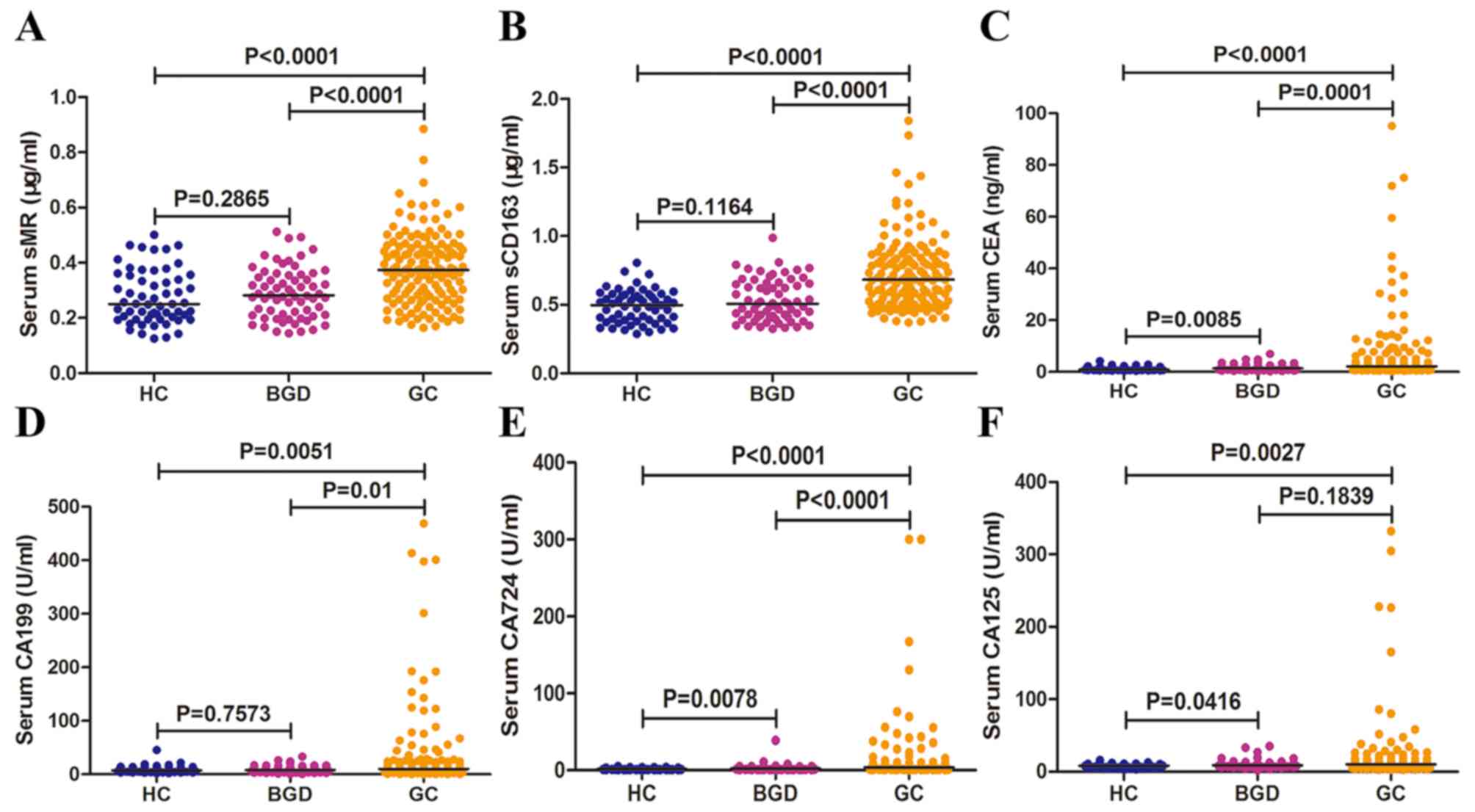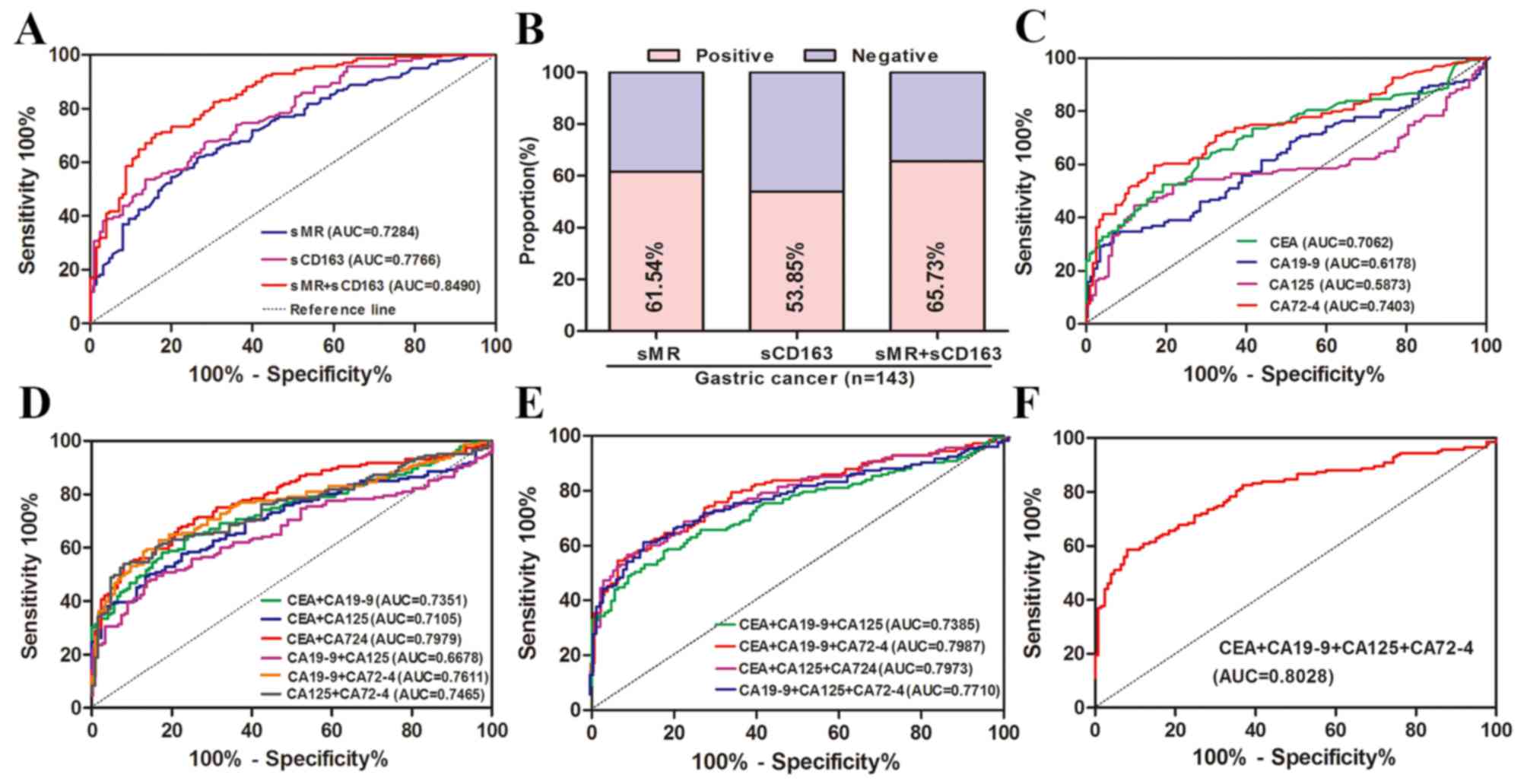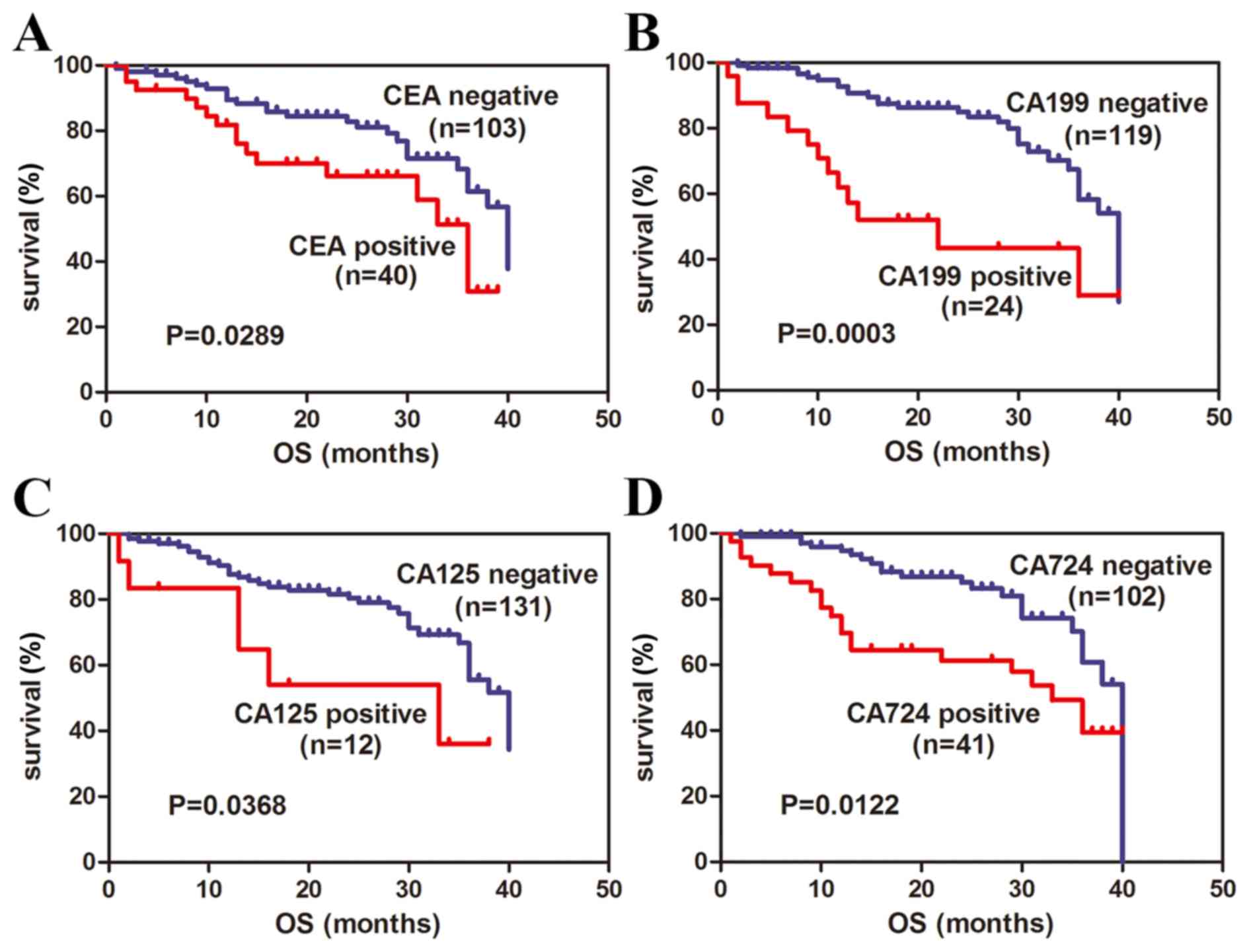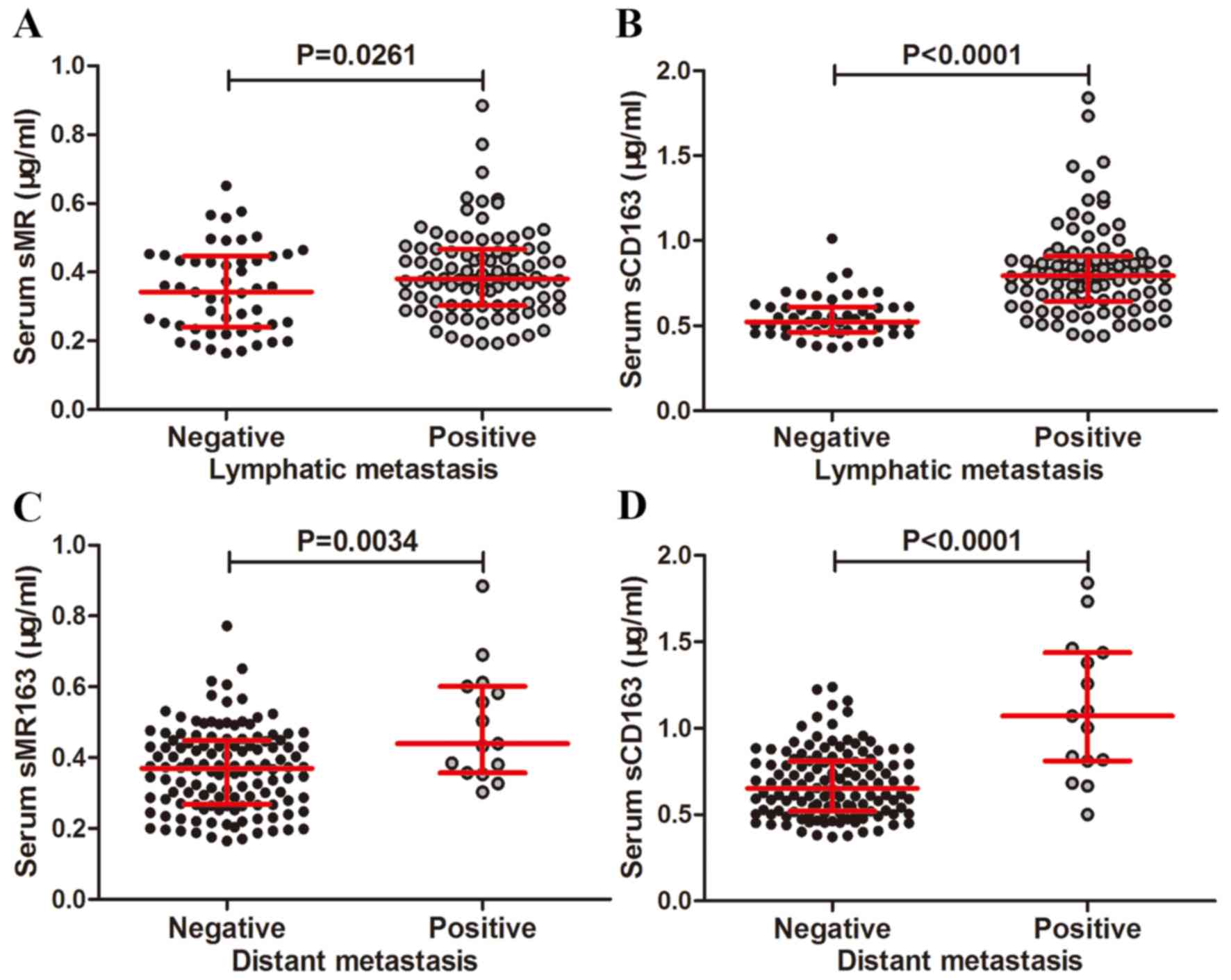|
1
|
Siegel RL, Miller KD and Jemal A: Cancer
statistics, 2015. CA Cancer J Clin. 65:5–29. 2015. View Article : Google Scholar : PubMed/NCBI
|
|
2
|
Zhou M, Wang H, Zhu J, Chen W, Wang L, Liu
S, Li Y, Wang L, Liu Y, Yin P, et al: Cause-specific mortality for
240 causes in China during 1990–2013: A systematic subnational
analysis for the global burden of disease study 2013. Lancet.
387:251–272. 2016. View Article : Google Scholar : PubMed/NCBI
|
|
3
|
Cohen DJ and Leichman L: Controversies in
the treatment of local and locally advanced gastric and esophageal
cancers. J Clin Oncol. 33:1754–1759. 2015. View Article : Google Scholar : PubMed/NCBI
|
|
4
|
Hu Y, Fang JY and Xiao SD: Can the
incidence of gastric cancer be reduced in the new century? J Dig
Dis. 14:11–15. 2013. View Article : Google Scholar : PubMed/NCBI
|
|
5
|
Martinez-Pomares L: The mannose receptor.
J Leukoc Biol. 92:1177–1186. 2012. View Article : Google Scholar : PubMed/NCBI
|
|
6
|
Irjala H, Alanen K, Grénman R, Heikkilä P,
Joensuu H and Jalkanen S: Mannose receptor (MR) and common
lymphatic endothelial and vascular endothelial receptor (CLEVER)-1
direct the binding of cancer cells to the lymph vessel endothelium.
Cancer Res. 63:4671–4676. 2003.PubMed/NCBI
|
|
7
|
Rødgaard-Hansen S, Rafique A, Christensen
PA, Maniecki MB, Sandahl TD, Nexø E and Møller HJ: A soluble form
of the macrophage-related mannose receptor (MR/CD206) is present in
human serum and elevated in critical illness. Clin Chem Lab Med.
52:453–461. 2014. View Article : Google Scholar : PubMed/NCBI
|
|
8
|
Rødgaard-Hansen S, Rafique A, Weis N,
Wejse C, Nielsen H, Pedersen SS, Møller HJ and Kronborg G:
Increased concentrations of the soluble mannose receptor in serum
from patients with pneumococcal bacteraemia, and prediction of
survival. Infect Dis (Lond). 47:203–208. 2015. View Article : Google Scholar : PubMed/NCBI
|
|
9
|
Kjærgaard AG, Rødgaard-Hansen S, Dige A,
Krog J, Møller HJ and Tønnesen E: Monocyte expression and soluble
levels of the haemoglobin receptor (CD163/sCD163) and the mannose
receptor (MR/sMR) in septic and critically ill non-septic ICU
patients. PLoS One. 9:e923312014. View Article : Google Scholar : PubMed/NCBI
|
|
10
|
Andersen MN, Andersen NF, Rødgaard-Hansen
S, Hokland M, Abildgaard N and Møller HJ: The novel biomarker of
alternative macrophage activation, soluble mannose receptor
(sMR/sCD206): Implications in multiple myeloma. Leuk Res.
39:971–975. 2015. View Article : Google Scholar : PubMed/NCBI
|
|
11
|
Kristiansen M, Graversen JH, Jacobsen C,
Sonne O, Hoffman HJ, Law SK and Moestrup SK: Identification of the
haemoglobin scavenger receptor. Nature. 409:198–201. 2001.
View Article : Google Scholar : PubMed/NCBI
|
|
12
|
Edge SB and Compton CC: The American joint
committee on cancer: the 7th edition of the AJCC cancer staging
manual and the future of TNM. Ann Surg Oncol. 17:1471–1474. 2010.
View Article : Google Scholar : PubMed/NCBI
|
|
13
|
Møller HJ, Peterslund NA, Graversen JH and
Moestrup SK: Identification of the hemoglobin scavenger
receptor/CD163 as a natural soluble protein in plasma. Blood.
99:378–380. 2002. View Article : Google Scholar : PubMed/NCBI
|
|
14
|
Karrasch T, Brünnler T, Hamer OW, Schmid
K, Voelk M, Herfarth H and Buechler C: Soluble CD163 is increased
in patients with acute pancreatitis independent of disease
severity. Exp Mol Pathol. 99:236–239. 2015. View Article : Google Scholar : PubMed/NCBI
|
|
15
|
Kazankov K, Rode A, Simonsen K, Villadsen
GE, Nicoll A, Møller HJ, Lim L, Angus P, Kronborg I, Arachchi N, et
al: Macrophage activation marker soluble CD163 may predict disease
progression in hepatocellular carcinoma. Scand J Clin Lab Invest.
76:64–73. 2016. View Article : Google Scholar : PubMed/NCBI
|
|
16
|
No JH, Moon JM, Kim K and Kim YB:
Prognostic significance of serum soluble CD163 level in patients
with epithelial ovarian cancer. Gynecol Obstet Invest. 75:263–267.
2013. View Article : Google Scholar : PubMed/NCBI
|
|
17
|
Nederby L, Roug AS, Knudsen SS, Skovbo A,
Kjeldsen E, Moller HJ and Hokland M: Soluble CD163 as a prognostic
biomarker in B-cell chronic lymphocytic leukemia. Leuk Lymphoma.
56:3219–3221. 2015. View Article : Google Scholar : PubMed/NCBI
|
|
18
|
Andersen MN, Abildgaard N, Maniecki MB,
Møller HJ and Andersen NF: Monocyte/macrophage-derived soluble
CD163: A novel biomarker in multiple myeloma. Eur J Haematol.
93:41–47. 2014. View Article : Google Scholar : PubMed/NCBI
|
|
19
|
Weaver LK, Pioli PA, Wardwell K, Vogel SN
and Guyre PM: Up-regulation of human monocyte CD163 upon activation
of cell-surface Toll-like receptors. J Leukoc Biol. 81:663–671.
2007. View Article : Google Scholar : PubMed/NCBI
|
|
20
|
Yang AP, Liu J, Lei HY, Zhang QW, Zhao L
and Yang GH: CA72-4 combined with CEA, CA125 and CA19-9 improves
the sensitivity for the early diagnosis of gastric cancer. Clin
Chim Acta. 437:183–186. 2014. View Article : Google Scholar : PubMed/NCBI
|
|
21
|
Nakata B, Hirakawa-YS Chung K, Kato Y,
Yamashita Y, Maeda K, Onoda N, Sawada T and Sowa M: Serum CA125
level as a predictor of peritoneal dissemination in patients with
gastric carcinoma. Cancer. 83:2488–2492. 1998. View Article : Google Scholar : PubMed/NCBI
|
|
22
|
Emoto S, Ishigami H, Yamashita H,
Yamaguchi H, Kaisaki S and Kitayama J: Clinical significance of
CA125 and CA72-4 in gastric cancer with peritoneal dissemination.
Gastric Cancer. 15:154–161. 2012. View Article : Google Scholar : PubMed/NCBI
|
|
23
|
Liang Y, Wang W, Fang C, Raj SS, Hu WM, Li
QW and Zhou ZW: Clinical significance and diagnostic value of serum
CEA, CA19-9 and CA72-4 in patients with gastric cancer. Oncotarget.
7:49565–49573. 2016. View Article : Google Scholar : PubMed/NCBI
|
|
24
|
Liu X, Qiu H, Liu J, Chen S, Xu D, Li W,
Zhan Y, Li Y, Chen Y, Zhou Z and Sun X: Combined preoperative
concentrations of CEA, CA 19-9, and 72-4 for predicting outcomes in
patients with gastric cancer after curative resection. Oncotarget.
7:35446–35453. 2016. View Article : Google Scholar : PubMed/NCBI
|
|
25
|
Sun Z and Zhang N: Clinical evaluation of
CEA, CA19-9, CA72-4 and CA125 in gastric cancer patients with
neoadjuvant chemotherapy. World J Surg Oncol. 12:3972014.
View Article : Google Scholar : PubMed/NCBI
|
|
26
|
Kwon OK, Yu W and Chung H: Prognostic
value of postoperative CA19-9 normalization in patients with
advanced gastric cancer. Hepatogastroenterology. 60:240–243.
2013.PubMed/NCBI
|
|
27
|
Shida A, Mitsumori N, Nimura H, Takano Y,
Iwasaki T, Fujisaki M, Takahashi N and Yanaga K: Prediction of
lymph node metastasis and sentinel node navigation surgery for
patients with early-stage gastric cancer. Word J Gastroenterol.
22:7431–7439. 2016. View Article : Google Scholar
|
|
28
|
Marttila-Ichihara F, Turja R, Miiluniemi
M, Karikoski M, Maksimow M, Niemelä J, Martinez-Pomares L, Salmi M
and Jalkanen S: Macrophage mannose receptor on lymphatics controls
cell trafficking. Blood. 112:64–72. 2008. View Article : Google Scholar : PubMed/NCBI
|



















